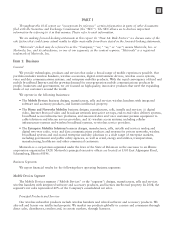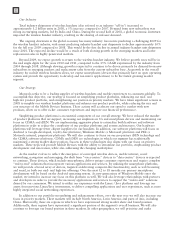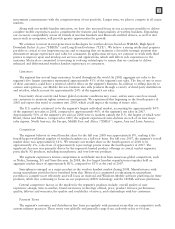Motorola 2008 Annual Report Download - page 17
Download and view the complete annual report
Please find page 17 of the 2008 Motorola annual report below. You can navigate through the pages in the report by either clicking on the pages listed below, or by using the keyword search tool below to find specific information within the annual report.
Payment Terms
Payment terms vary worldwide, depending on the arrangement. In North America, payment is generally due
30 to 60 days from the invoice date. In regions outside of North America, terms vary widely but are typically
limited to no more than 90 days. Contracts for wireless networks typically include implementation milestones,
such as delivery, installation and system acceptance, which generally take 30 to 180 days to complete. Invoicing
the customer is dependent on the completion of the milestone.
As required for competitive reasons, extended payment terms are provided to customers from time-to-time on
a limited basis. The segment’s payment terms are consistent with industry practice, as many of our contracts are
awarded through a competitive bid process. When required for competitive reasons, we may provide long-term
financing in connection with equipment purchases. Financing may cover all or a portion of the purchase price.
Regulatory Matters
Many of our products are subject to regulation by the FCC in the United States and other communications
regulatory agencies around the world. In addition, our customers, and their networks into which our products are
incorporated, are subject to government regulation. Government regulatory policies affecting either the willingness
or the ability of cable and telecom operators, wireless operators and wireline operators to offer certain services, or
the terms on which these operators offer the services and conduct their business, may have a material adverse
effect on the segment’s results. Motorola has developed products using trunking and data communications
technologies to enhance spectral efficiencies. The growth and results of the wireless communications industry may
be affected by regulations impacting access to allocated spectrum for wireless communications users, especially in
urban areas where the spectrum is heavily used.
Historically, reception of digital television programming from a cable broadband network has required a set-
top with security technology. This security technology has limited the availability of set-tops to those manufactured
by a few cable network manufacturers, including Motorola. FCC regulations requiring separation of security
functionality from set-tops that are aimed at increasing competition and encouraging the sale of set-tops in the
retail market became effective for most customers in 2007. Traditionally, cable service providers sold or leased
their set-top to their customer. As the retail market develops for set-tops and televisions capable of accepting the
security modules, sales of our set-tops which are sold to cable providers may be negatively impacted.
The U.S. leads the world in spectrum deregulation, allowing new wireless communications technologies to be
developed and offered for sale. Examples include wireless local area network systems, such as WiFi, and wide area
network systems, such as WiMAX and LTE. Other countries have also deregulated portions of their available
spectrum to allow deployment of these and other technologies. Deregulation may introduce new competition and
new opportunities for Motorola and our customers.
As more fully described under “Enterprise Mobility Solutions — Regulatory Matters”, as television
transmission and reception technology transitions from analog to more efficient digital modes, various countries
around the world are examining, and in some cases already pursuing, the redevelopment of portions of the
television spectrum. Certain segments of the spectrum that have historically been utilized for analog television have
now been designated to support new commercial communications systems and, therefore, are expected to generate
new business opportunities for Motorola in wireless and video technologies. In the U.S., the FCC conducted an
auction of spectrum for the 700 MHz band that is expected to be reclaimed by the government on June 12, 2009.
License for this spectrum may be used for flexible fixed, mobile and broadcast applications. Although the auction
winners will determine the best utilization of the acquired spectrum, both LTE and WiMAX are candidates for
technology selection. In addition, a contiguous portion of this spectrum has generated interest for mobile TV
applications.
Backlog
The segment’s backlog was $2.3 billion at December 31, 2008, compared to $2.6 billion at December 31,
2007. The 2008 order backlog is believed to be generally firm and 100% of that amount is expected to be
recognized as revenue during 2009. The forward-looking estimate of the firmness of such orders is subject to
future events that may cause the amount recognized to change.
Intellectual Property Matters
Patent protection is extremely important to the segment’s operations. The segment has an extensive portfolio
of patents relating to its products, systems, technologies and manufacturing processes.
9
























